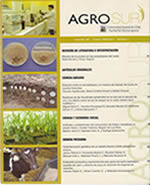Is there a response to strategic supplementation of yearling steers grazing sudangrass and forage sorghum?
Main Article Content
Abstract
Within the context of sustainable intensification of extensive livestock production systems, the inclusion of reduced areas of high productivity combined with strategic supplementation would allow an animal production increase. Sudangrass and direct grazing sorghum appear as alternatives because of their agroecological adaptation and high forage production. To evaluate the effect of these forage basis combined with the use of protein supplementation on average daily gain (ADG) and live weight (LW), 40 Hereford yearling steers (LW, Year 1 = 287 ± 35 kg; Year 2 = 271 ± 19 kg) were used in a random 2 x 2 factorial design for two years, where forage basis (sudangrass – Sd – or BMR sorghum – Sg) and supplementation (0.8% LW with sunflower expeller: with – S – or without – NOS) were evaluated. The animals were randomly allocated to 4 treatments with two replicates: SdNOS, SdS, SgNOS, and SgS. Average daily gain was significantly affected by forage basis and supplementation (Sd = 0.833 vs. Sg = 0.899 kg animal-1 d-1, P < 0.05; NOS = 0.739 kg animal-1 d-1 vs. S = 0.992 kg animal-1 d-1, P < 0.01), as was final LW (Sd = 342.3 vs. Sd = 347.1 kg, P < 0.05; NOS = 334.7 kg vs. S =354.7 kg; P < 0.01). The use of forage sorghums combined with strategic supplementation improved the rearing of steers during summer.

